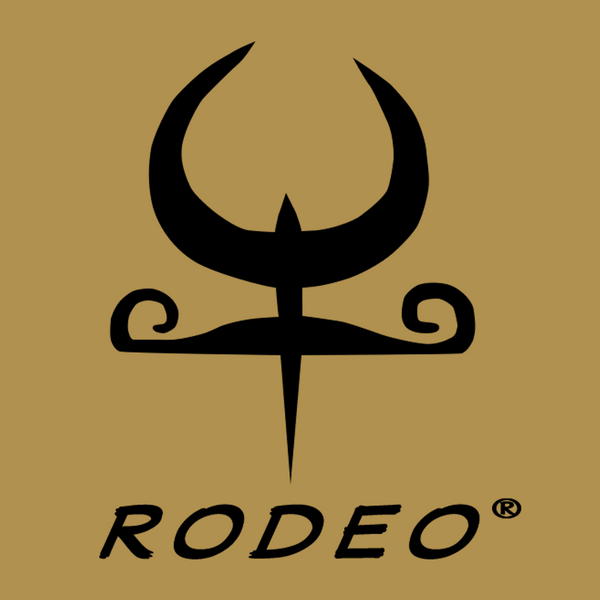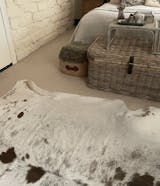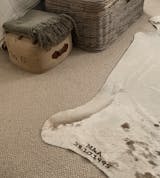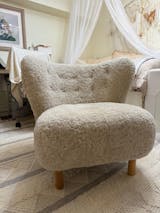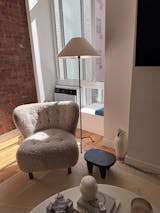
How to Make a Genuine Cowhide Rug: The Complete Process from Hide to Home Décor
alicia bengenShare
Have you ever wondered how a genuine cowhide rug is made?
Cowhide rugs are a great option for enhancing any living space, adding both natural beauty and rich texture to your interior design. These rugs are a popular choice for many homeowners due to their exceptional quality, durability, and unique natural patterns.
The cowhide rug industry has grown in recent years, with customers looking for the highest quality cowhide to complement their home improvement projects.
Many people wonder, what is a cowhide rug? A cowhide rug is a unique area rug made from genuine cowhide or designed with a cow print pattern. Inspired by the natural beauty of cattle, these rugs are perfect for those who love farm, Western, country, and rustic elements in their home décor. Whether you want to add a touch of the wild frontier or a cozy farmhouse charm, a cowhide rug brings warmth, texture, and character to any space. For a deeper dive into cowhide rugs, check out our blog, where we explore everything you need to know. Read more here!
In today's home décor market, there are two types of cowhide rugs: faux cowhide rugs (also known as fake cowhide rugs) and genuine cowhide rugs (also called real or authentic cowhide rugs). To help you decide which one is best for you, we've written detailed blogs comparing their differences. Read more here!
In this blog, we’ll take you behind the scenes to understand how a genuine cowhide rug is made—where it comes from, the process behind its creation, and how livestock is ethically transformed into a stunning focal point for your home décor. Read on to discover the journey of a cowhide rug!
Intro
From preserving the natural hair on the hide to the tanning process, crafting a genuine cowhide rug is a meticulous art. Unlike traditional leather tanning, where the hair is removed, this method keeps the hide’s unique texture, markings, and softness intact. Each step is carefully executed to enhance durability and beauty, transforming raw cowhide into a stunning area rug—perfect for your living room, dining room, or home office.
Step 1: Sourcing the Best Cowhides
The first step is selecting the best cowhides from the meat industry, ensuring only premium-quality hides are used. These raw materials come from cattle raised primarily for dairy products and beef, making cowhide a natural product that is sustainably sourced.

Brazil is known for producing Brazilian Cowhide, which is often considered the best quality of cowhide due to its supple cowhide texture and exceptional quality. Other popular choices include Tricolor Cowhide, Black Cowhide Rugs, White Cowhide Rugs, and Beige Cowhide Rug variations, each offering different colors and natural patterns.
Countries like Argentina, Colombia, and India are also major producers of hair-on cowhide rugs, known for their craftsmanship and high-quality tanning processes. These regions have a long history of leather production, making them key players in the global cowhide rug market.
Step 2: Curing the Hide
Once the hide is collected, it is cured with salt to prevent decomposition. The hide is spread out, and a thick layer of salt is applied to draw out moisture and preserve it for transport to the tannery. This process can take several days to weeks, depending on the climate and size of the hide.

Step 3: Cleaning & Prepping
Soaking in water to remove excess salt and dirt.
De-fleshing to remove any remaining fat or muscle tissue.
Liming process, where the hide is treated with a mild chemical solution to loosen hair follicles and soften the hide. Since hair-on cowhide rugs retain their hair, this step is carefully monitored to ensure the hair remains intact.
Step 4: Chrome Tanning
The tanning process is crucial in transforming raw cowhide into a durable, soft, and long-lasting rug. Tanneries use chrome tanning, where chromium salts penetrate the hide to:
✔️ Preserve the hide and prevent decay.
✔️ Enhance softness, flexibility, and durability.
✔️ Make the hide resistant to shedding and cracking.
✔️ Maintain its natural hair, texture, and colors.
To ensure even absorption of tanning agents, the hides are placed in large rotating drums. The tumbling action allows chromium salts or vegetable tannins to penetrate uniformly, making the hide supple, resilient, and resistant to shedding. It also helps clean the hair, enhance dye absorption, and infuse conditioning oils for long-lasting quality. This step significantly reduces tanning time while preserving the hide’s natural beauty and texture.

While chrome tanning is the most common method, some hides undergo vegetable tanning or an extra fat treatment to further improve softness, quality, and longevity, ensuring they remain durable and resistant to decomposition for years.
The tanning process also determines the final color and texture of the rug. Some cowhide rugs maintain their natural tones, while others are dyed or treated to achieve metallic finishes or special bluish-grey tint effects, adding a unique decorative touch.
Step 5: Drying & Stretching
After tanning, the hide is:
- Stretched on frames to maintain its shape.
- Hung or laid flat to air-dry naturally.
- Softened through mechanical processes, ensuring a smooth, pliable texture.
Proper drying prevents shrinkage and warping.

Step 6: Trimming & Shaping
Once dry, the hide is:
✔️Trimmed into a natural shape to remove uneven edges.
✔️Checked for imperfections and minor touch-ups.
✔️Brushed and polished to enhance its shine and softness.
We also apply a light protective coating to prevent spills and stains.
Step 7: Final Touches & Quality Check
Each cowhide rug undergoes a final inspection to ensure:
✔️No loose hair or bald spots.
✔️The hide is soft, supple, and free of defects.
✔️Colors and patterns are natural and well-preserved.

Before being shipped to customers, the hides go through an inspection to ensure they meet top quality standards. Some real cowhide rugs may have white spots, while others have a bluish-grey tint—all of which contribute to their uniqueness.
Unlike a Faux Cowhide Rug or Faux Hide, a genuine cowhide rug offers a rich texture, great job in craftsmanship, and natural beauty that synthetic materials simply cannot replicate. Unfortunately, some manufacturers use hidden ingredients in imitation rugs, making it essential to verify authenticity when purchasing.
How to Care for Your Cowhide Rug
To maintain the best quality of cowhide, follow these cleaning tips:
✔️Shake or vacuum (without a beater bar) regularly.
✔️Spot clean with a damp cloth and mild soap.
✔️ Keep away from direct sunlight to prevent fading.
✔️Use a cowhide protector for home improvement projects.
For more tips, check out here.
If you accidentally spill liquid on your cowhide rug, simply wipe it up with a damp cloth and Rodeo Cowhide Shampoo, our specialized cowhide cleaning solution, for a quick and effective clean.
Where to Buy the Best Cowhide Rugs?
Looking for 5-Star Customer Service and free shipping on top quality cowhide rugs?
Read our blog: How to Buy Cowhide Online
Now You Know How a Genuine Cowhide Rug Is Made
The process of transforming raw cowhide into a high-quality cowhide rug is intricate and requires expert craftsmanship. From carefully selecting premium hides to the tanning and finishing process, each step plays a crucial role in creating a durable, beautiful, and long-lasting rug—perfect for your home office, dining room, or living space.
Choosing a genuine cowhide rug over a faux alternative ensures you get a natural, high-quality product that stands the test of time. Whether you prefer a Calfhide Rug, Brazilian Cowhide, or White Cowhide Rug, investing in authentic cowhide guarantees exceptional quality, durability, and timeless style.
